First Impressions of Marvel’s Avengers
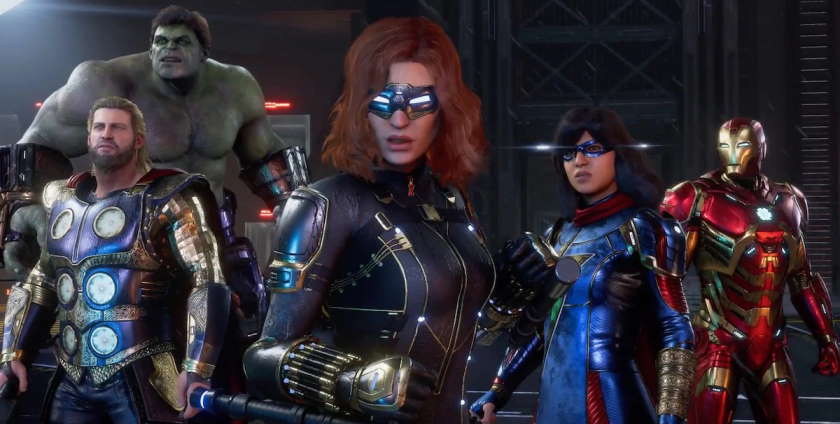
Over the past several years I’ve written a lot about Destiny 2, and spoken even more words when recording the podcast. I’ve had a love/hate relationship that has finally achieved a peaceful acceptance. The grind will never be perfect, but the combat is so solid that it’s enjoyable enough to just dive back in with friends every so often.
Without that top-notch satisfaction of popping the skulls off of Fallen troopers or melting strike bosses into paste with my Hunter’s damage enhancing void tethers, it wouldn’t last. There would be no debates about whether Destiny 2 is worth returning to because the gameplay wouldn’t sustain the over 500 hours spent on it. Though my friends and I gripe about having to slaughter the giant Worm God thing for the umpteenth time, or being slotted into running Savathun’s Song yet again, the repetition is less a problem and more an inconvenience due to each individual skirmish remaining exciting, engaging, and, for lack of a better word, fun.
I did not get to sit down and co-op a mission with Steve during the beta for Marvel’s Avengers, nor did I truly get to experience the majority of multiplayer content on offer. I plan to do so during the Open Beta this weekend and the next. My time with the Closed Beta was spent completing the single player missions, the first “multiplayer” mission, and then the first HARM room exercise – a sort of practice arena that allows you to experiment with character move sets while simultaneously tackling challenges. When I had completed that first multiplayer mission, I leaned back in my seat, looked at the screen, and asked myself a simple question:
Could I repeat this same mission as often as Savathun’s Song or the Giant Worm God in Destiny 2 and have a good time?
The conclusion I came to is “no”. Whereas Destiny 2 contains some of the best, most satisfying first-person shooting in the industry, Marvel’s Avengers fails to measure up to other melee action combat games in the medium. Last year’s Devil May Cry 5 was one of my favorite games of the year, one whose combat is designed for mastery and replayability. Higher difficulties will remix combat encounters so that you run into different, often more difficult enemies earlier than you would have in the standard campaign. Bayonetta and The Wonderful 101 operate similarly, where the standard difficulties are a sort of “tutorial” run. Get adjusted to the mechanics, expand your moveset, and learn how the different enemies operate before jumping into the real challenge of the higher difficulty settings. They are able to get away with this because the combat is satisfying enough on a baseline to make repeat playthroughs unnecessary for most players, while offering incredible depth for the more enthusiastic challenge-craving crowd ready to spend two-hundred hours or more within the horde-mode style Bloody Palace alone.
Admittedly, I aim to spend more time with the Open Beta to get a better feel for why the combat in Marvel’s Avengers is so unsatisfying. However, on a simple, base-level, it fails to properly engage as much as even the earliest levels of a Capcom or PlatinumGames action title manage to deliver.
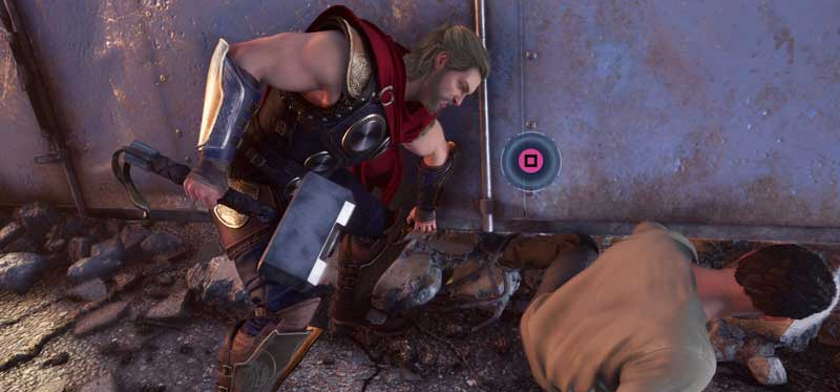
Mash button, receive gameplay
It is tempting to try and defend Avengers considering all of the different character styles it is accounting for, but each of the games I’ve referenced provide a variety of characters, weapons, or fighting styles so that the player can customize and express their personal combat preferences more freely. Devil May Cry 5 possesses three characters that each play differently from one another, with Dante himself being the most dynamic. Not only does he have a whole arsenal of weaponry, each with its own unique moveset, pace, and power, but he has four separate “styles” that further adjust his moveset. He alone is as varied, if not moreso, than the combined differences between Thor, Black Widow, Ms. Marvel, and quite possibly Captain America.
Which, perhaps, is one of the flaws behind the game. Suspension of disbelief is easily broken once you’re playing as the Incredible Hulk, a near-invulnerable being whose strength ought to be so overwhelming and uncontested that he is as unstoppable as a force of nature. Instead, his punches are as weak as the president of the high school Chess club trying to slam his fist into the jaw of the senior varsity wrestling champion. Enemies will accept Hulk’s blows without flinching, winding up their own retaliatory strikes capable of knocking the not-so-jolly green giant to his knees.
If we were to follow the logic of the comic book source material, Hulk would easily overpower all of the other characters. Most of your opponents would be defeated with a single flick, let alone a full blown punch. Who would play one of the weaker, inferior heroes when you could just dominate the battlefield as big green?
Perhaps it would have been better to leave Hulk as an unplayable character. Something more akin to a summon, occasionally called in to assist the player. To do so would, however, go against one of the game’s biggest draws: the ability to play as the Avengers.
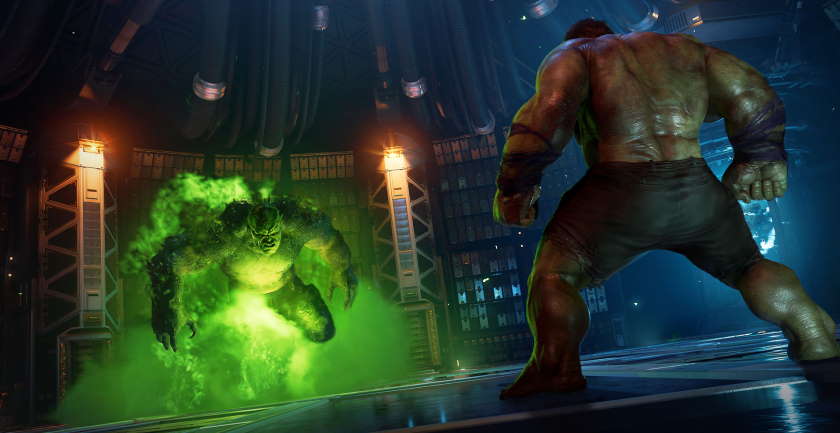
Gonna be honest, I forgot this fight even happened.
An experience that could have, perhaps, worked better as a single-player experience rather than cooperative live service model. Black Widow missions could easily have been stealth-espionage in design, reducing direct combat while emphasizing knock-out takedowns and acrobatic navigation of the environment. Iron Man would give players the opportunity to soar through the skies, weaving between skyscrapers as they chased down aerial bogeys. Hulk and Thor combat would focus on trashing waves upon waves of mooks beneath your Demigod fists and hammer not unlike a Dynasty Warriors game. Without having to concern oneself with balance between players, the game could have better customized its characters and their levels to better highlight their powers and prowess.
Instead, the might of Mjolnir packs less of a punch than it does a half-hearted smack to the cheek. The God of Thunder requires a minimum of three blows with his hammer in order to take out a standard human mook, and that’s in the far easier opening tutorial mission.
Considerations of power aside, I honestly believe this game’s combat feels so mediocre in part due to its presentation. The game’s audio engineer opted for the more realistic “two cold steaks smacking together” sound that punching makes in real life as opposed to the solid, bone-crunching pounding of an Indiana Jones film. The sense of “impact” is attempted to be delivered through screen shake and vibrating controllers, but it’s simply not enough to provide satisfying kinaesthetics – the “feel” of combat, so to speak.
The sound of combat is just as important as the vibration of the controller or shaking of the screen. Ghost of Tsushima’s assassinations implement the slick slicing of killer cutlery through flesh, the splatter of blood upon grass, and the gurgling of the Mongol victim choking on his own blood. It delivers such a visceral sense of murder that it would have set a whole moral panic off in the 90’s.
We need not even compare it to other video games. The original Thor film punctuates each swing of Mjolnir with a metallic clang and/or a profound, percussive smack into the frost giants. There’s no doubt of how strong the Norse God is, nor how painful it must be to get struck by his hammer.
There are additional visual flourishes that can be used to increase the sense of speed or impact of a blow. I find the audio of standard blows in the Batman Arkham games to lack similar “punch”, but each strike is combined with a brief flash of impact lines that presumably inspired some of the visual effects in Scott Pilgrim vs. The World (which, sadly, I can no longer find a specific quote as evidence; this Popular Mechanics article is the only source I can find and it fails to confirm that precise trivia that I picked up from somewhere). The camera will also briefly slow down just before landing a Critical Strike, the sickening crunch of bone punctuating the goon’s pain as Batman’s fist or heel digs itself into their face.
Ryu Ga Gotoku studio games like Judgment include particle effects to deliver a “trail” behind each punch, emphasizing power as well as giving it a greater sense of speed. The stylistic “heat” or “EX” actions allow for powerful blows to be delivered with a dynamic camera and an over-the-top flourish.
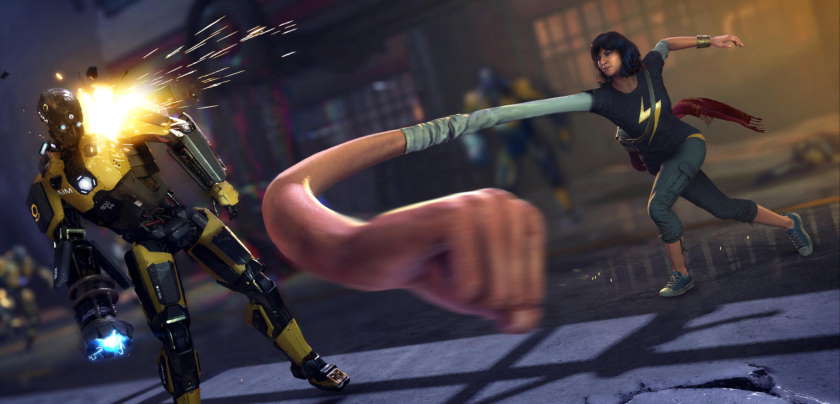
This screenshot is more impactful and exciting than actually playing the game.
Disregarding the video editor’s inclusion of rock music, we can see many of these visual and audio elements combined within this demonstration of Ninja Gaiden 2 gameplay. Each swing of the blade is followed by a white trailing blur line, emphasizing the speed at which the sword is swung. Landed blows are accompanied by “impact lines” like in the Arkham games, crimson blood splashing into the air and coating the walls to further communicate a successful cut. Every sharp slice of Ryu’s katana sounds slick to the ear. The screen only shakes during certain types of attacks, with its greatest, most violent shaking occurring during finishing moves. In other words, the camera is steady when the player has a moment to breath and focus their attention away from the surrounding opponents.
Marvel’s Avengers has a bare minimum of visual and aural feedback. Such stimulus of the senses is necessary not only for creating a visual identity and sense of style, but for providing feedback to the player beyond basic confirmation of impact. It allows the player’s strikes to feel powerful, as if each strike is dealing real damage to the opponent. Crystal Dynamics relied purely on enemy health bars to communicate that information, which only leads the player to wonder why their superheroes aren’t able to wipe these foes out in a single blow.
In other words, by having such a lackluster presentation of action combat, it only emphasizes the mechanical problems of Marvel’s Avengers.
Granted, I’m also comparing this game to a lot of titles that are certainly more complex and rewarding, but are also not designed for as wide a market as Square Enix and Crystal Dynamics are aiming for. It does not excuse their shortcomings in presentation, but you’re never going to appeal to a wide audience if you’re trying to build a game to compete directly with Devil May Cry 5 or Bayonetta.
Even so, everyone’s friendly neighborhood Spider-Man managed just fine in 2018. I had plenty of issues with the game and the manner in which it held some of the best abilities hostage behind a skill tree. However, the combat designers carefully considered what sort of superhero Spider-Man was when designing his moveset. He’s mobile, quick, and capable of hanging in the air in ways other heroes can’t. His webs give him a far greater reach than other heroes get to enjoy. As such, Spider-Man can slip between the legs of big heroes, swing manhole covers at them, or pull them into the air towards him. It’s a satisfying combat system kept simple enough for young and casual fans while appealing to enthusiastic core gamers looking for some depth.
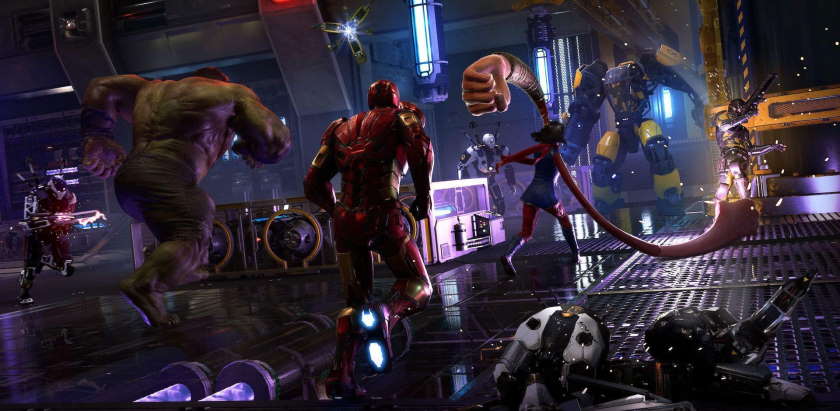
Exciting looking screenshot taken just before Hulk gets caught up in a pathetic looking slap-fight with a puny human in a hazmat suit.
Of course, I also managed to beat Spider-Man, a feat that is not yet possible with Marvel’s Avengers. Though I did not find myself nearly so bored in the early days of the wall crawler’s adventure, I certainly found many of the later abilities to have been essential. It is possible more time with the Open Beta will change my tune a bit, but I somehow doubt it.
After all, Spider-Man was Spider-Man, and Insomniac designed the entire combat system to take advantage of his abilities. Marvel’s Avengers are Ms. Marvel, Hulk, Black Widow, Iron Man, Thor, and Captain America. That’s a diverse set of characters that need to be carefully balanced not to overpower one or the other. Kept unique, but not so unique that one easily outshines the other.
That’s a far, far easier task to accomplish in a first-person shooter, where your special abilities are effectively gun types rather than combat styles. Here, in this third-person action game, it feels as if there’s no real identity or difference between characters beyond some of the superficial. They each have a ranged attack. Some, such as Hulk’s debris tossing, come with some additional jank based on the button presses. Others come with a limited range, such as Ms. Marvel’s long-range punch.
At the end of the day, however, they’re largely all controlling the same. It’s a shallow pond filled with damage sponge opponents and button-mash melee combat.
Were this a single-player game whose narrative I could complete in fifteen-to-twenty hours, I think it would be fine. I mean, the Yakuza franchise hardly has combat that measures up to the best of Capcom or PlatinumGames as well. However, those are narrative-based games that, once I’m finished with one, I’m done. I can take a break for a few months before swapping over to the next.
Asking me to log in every week for such mediocre combat for the sake of boosting my numbers a smidgen is too much to ask.


